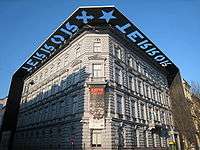House of Terror
| Terror Háza | |
|
House of Terror | |
| Established | 24 February 2002 |
|---|---|
| Location | Budapest, Hungary |
| Coordinates | 47°30′25″N 19°03′55″E / 47.50694°N 19.06528°E |
| Visitors | more than 1,000 per day |
| Director | Dr Mária Schmidt |
| Website | terrorhaza.hu |
House of Terror is a museum located at Andrássy út 60 in Budapest, Hungary. It contains exhibits related to the fascist and communist regimes in 20th-century Hungary and is also a memorial to the victims of these regimes, including those detained, interrogated, tortured or killed in the building.
The museum opened on 24 February 2002 and the Director-General of the museum since then has been Dr Mária Schmidt.
The House of Terror is a member organisation of the Platform of European Memory and Conscience.[1] Visitors including Zbigniew Brzezinski, Francis Fukuyama and Hayden White have praised the Museum.[2][3]
Building
The building was used by the Arrow Cross Party and AVH.
The museum was set up under the centre-right government of Viktor Orbán. In December 2000 the Public Foundation for the Research of Central and East European History and Society purchased the building with the aim of establishing a museum in order to commemorate these two bloody periods of Hungarian history.
During the year-long construction work, the building was fully renovated inside and out. The internal design, the final look of the museum's exhibition hall, and the external facade are all the work of architect Attila F. Kovács. The reconstruction plans for the House of Terror Museum were designed by architects János Sándor and Kálmán Újszászy. The reconstruction turned the exterior of the building into somewhat of a monument; the black exterior structure (consisting of the decorative entablature, the blade walls, and the granite footpath) provides a frame for the museum, making it stand out in sharp contrast to the other buildings on Andrássy Avenue. Inside the building, the Museum has a T-54 tank on display.
Permanent exhibition
With regard to communism and fascism, the exhibition contains material on the nation's relationships to Nazi Germany and the Soviet Union. It also contains exhibits related to Hungarian organisations such as the fascist Arrow Cross Party and the communist ÁVH (which was similar to the Soviet Union KGB secret police). Part of the exhibition takes visitors to the basement, where they can see examples of the cells that the ÁVH used to break the will of their prisoners.
Much of the information and the exhibits is in Hungarian, although each room has an extensive information sheet in both English and Hungarian. Audio guides in English and German are also available.
The background music to the exhibition was composed by former Bonanza Banzai frontman and producer Ákos. The scoring includes the work of a string orchestra, special stereophonic mixes, and sound effects.
Visitors may not take photographs or use video cameras inside of the building. There is no reduced fee for ICOM members.
Controversy

Some historians, journalists, and political scientists such as Magdalena Marsovszky or Ilse Huber have argued that the museum portrays Hungary too much as the victim of foreign occupiers and does not recognise enough the contribution that Hungarians themselves made to the regimes in question as well.[4][5] Criticism has also been raised that far more space is given to the terror of the communist regime than the fascist one. One answer to these criticisms was that while the German occupation and fascist regime of Ferenc Szálasi lasted less than a year, the Hungarian Communist regime lasted for 40 years. The museologists of the museum also reminded critics that the Hungarian Holocaust has its own museum, within a kilometre distance, so there is no need to repeat its content. Mária Schmidt considers these debates to be primarily politically motivated attacks.[6] Defenders of the museum also point out that several people who are subjects of the exhibition have ties to the Alliance of Free Democrats, such as Miklós Bauer, who is the father of the parliament member Tamás Bauer.[7] Also,both of the parents of Iván Pető, prominent leader of the Alliance of Free Democrats in the early 1990s, were ÁVH agents and their photos are on display as such in the museum.[8] Schmidt has responded to criticisms of the museum's political nature by saying "Is there anything in history that is not related to politics?"[9]
References

- ↑ "Czech Prime minister Petr Nečas: The years of totalitarianism were years of struggle for liberty". Platform of European Memory and Conscience. 14 October 2011. Retrieved 20 October 2016.
- ↑ Kisantal Tamás, Krommer Balázs (2005). "Discussion with Hayden White" (PDF) (in Hungarian). Retrieved November 10, 2016.
- ↑ A Terror Háza honlapja
- ↑ Huber, Ilse. "Das Haus des Terrors in Budapest: Umstrittenes Museum über Ungarns Zeitgeschichte" (in German). Retrieved February 18, 2011.
- ↑ Marszovszky, Magdalena (2011). "“Die Märtyrer sind die Magyaren”. Der Holocaust in Ungarn aus Sicht des Hauses des Terrors in Budapest und die Ethnisierung der Erinnerung in Ungarn" [“The Martyrs are the Magyars”. The Holocaust in Hungary from the Perspective of the House of Terror in Budapest and the Ethnification of Memory in Hungary]. In Globisch, Claudia; Pufelska, Agnieszka; Weiß, Volker. Die Dynamik der europäischen Rechten. Geschichte, Kontinuitäten und Wandel [The Dynamics of the European Right. History, Continuity and Change] (in German). Wiesbaden: VS Verlag für Sozialwissenschaften. pp. 55–74. ISBN 978-3-531-17191-3.
- ↑ "Socialists grab every occasion to cramp the House of Terror" (in Hungarian). Retrieved February 18, 2011.
- ↑ Tamas S. Kiss. "Museum facade ruling". Museum Security Mailinglist Reports. Retrieved February 18, 2011.
- ↑ Fodor Gyöngyvér (January 10, 2003). "Az újságíró asszony haragszik" (in Hungarian). Retrieved February 18, 2011.
- ↑ Fuller, Thomas (August 2, 2002). "Stark history / Some see a stunt : Memory becomes battleground in Budapest's House of Terror". The New York Times. Retrieved February 18, 2011.
External links
| Wikimedia Commons has media related to House of Terror Museum. |


